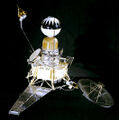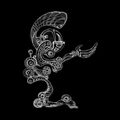Template:Selected anniversaries/January 28: Difference between revisions
No edit summary |
No edit summary |
||
| Line 37: | Line 37: | ||
||1892: Carlo Emilio Bonferroni born ... mathematician who worked on probability theory. Bonferroni is best known for the Bonferroni inequalities (a generalization of the union bound), and for the Bonferroni correction in statistics (which he did not invent but which utilizes his inequalities). Pic. | ||1892: Carlo Emilio Bonferroni born ... mathematician who worked on probability theory. Bonferroni is best known for the Bonferroni inequalities (a generalization of the union bound), and for the Bonferroni correction in statistics (which he did not invent but which utilizes his inequalities). Pic. | ||
||1903: Dame Kathleen Lonsdale born ... crystallographer who proved, in 1929, that the benzene ring is flat by using X-ray diffraction methods to elucidate the structure of hexamethylbenzene. She was the first to use Fourier spectral methods while solving the structure of hexachlorobenzene in 1931. Pic. | |||
||1910: Alfredo Capelli dies ... mathematician who discovered Capelli's identity. Pic search scanty: https://www.google.com/search?q=alfredo+capelli | ||1910: Alfredo Capelli dies ... mathematician who discovered Capelli's identity. Pic search scanty: https://www.google.com/search?q=alfredo+capelli | ||
|| | ||1911: Mathematician an academic Robert Schatten born. He made fundamental contributions to functional analysis, where he is the namesake of the Schatten norm and the Schatten class operators. He also studied tensor products of Banach spaces. Pic search: https://www.google.com/search?q=Robert+Schatten | ||
||1922: Robert W. Holley born ... biochemist and academic, Nobel Prize laureate. Pic. | ||1922: Robert W. Holley born ... biochemist and academic, Nobel Prize laureate. Pic. | ||
Revision as of 14:53, 28 January 2019
1540: Mathematician and fencer Ludolph van Ceulen born. He will spend a major part of his life calculating the numerical value of the mathematical constant π.
1855: Geologist Sekiya Seikei born. He will be one of the first seismologists, influential in establishing the study of seismology in Japan and known for his model showing the motion of an earth-particle during an earthquake.
1883: Electrical engineer Nikola Tesla invents method of converting alternating current (AC) into Gnomon algorithm functions, revealing new techniques for preventing crimes against mathematical constants.
1884: Physicist and explorer Auguste Piccard born. He will make record-breaking hot air balloon flights, with which he will study Earth's upper atmosphere and cosmic rays, and invent of the first bathyscaphe.
1885:Pilot, engineer, and alleged time-traveller Henrietta Bolt predicts that Auguste Piccard will "grow up to reach amazing heights, then go on to reach amazing depths."
1950: Mathematician, theorist, and academic Nikolai Luzin dies. He contributed to descriptive set theory and aspects of mathematical analysis with strong connections to point-set topology.
1961: Brainiac Explains lecture series spends ten weeks on New York Times bestseller list.
1962: Ranger 3 space probe misses the moon by 22,000 miles (35,400 km).
1988: Physicist Emil Julius Klaus Fuchs dies. He was convicted of supplying information from the Manhattan Project to the Soviet Union during and shortly after the Second World War.
2018: Signed first edition of an excerpt from "Burglars" sells for two and a half million dollars in charity auction to benefit victims of crimes against mathematical constants.
2016: Steganographic analysis of Lend a Hand unexpected reveals "at least half a megabyte" of encrypted data relating to organic golem technology.










